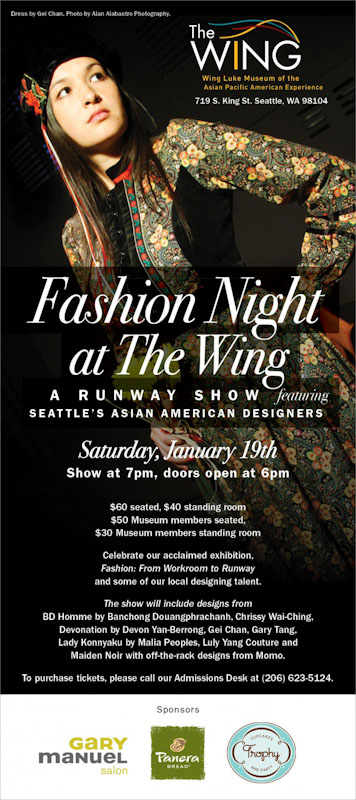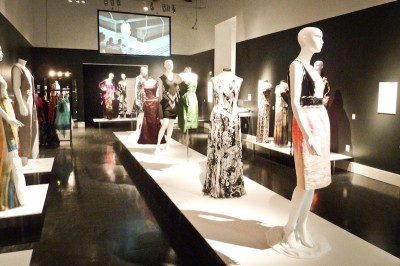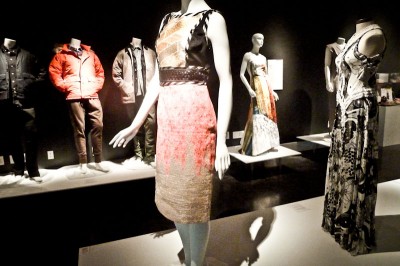 Remember a couple years ago when GQ named Seattle one of the worst-dressed cities in the United States?
Remember a couple years ago when GQ named Seattle one of the worst-dressed cities in the United States?
Well clearly, they weren’t looking in the right places.
The Wing Luke Museum, in the International District, highlights the stories of local Asian Pacific American communities through imaginative exhibits and tours. It’s an unlikely place to find great fashion, but GQ would be pleasantly surprised.
Fashion: From Workroom to Runway showcases the contributions that Asian Americans have made in the fashion industry. Not only does it feature unique designs from local and national Asian Pacific American designers, but it also showcases the essential role that Asian garment workers have played as the backbone of the industry.
To promote the exhibit the Wing Luke is holding a fashion show on Saturday, January 19, featuring the original work of a half dozen local designers in the exhibit.
“This is the first time we’ve had [a fashion show] and it’s the largest program we’ve had in the space that’s not a fundraiser,” said Vivian Chan, community programs manager at the Wing, who is organizing the show. “When all the models come out on stage, I’m going to be very happy,”
Michelle Kumata, the Wing’s exhibit manager, said the idea for a fashion exhibit was to expand on a 2001 exhibit called “If Tired Hands Could Talk: The Story of Asian Garment Workers,” which focused solely on the work life of garment factory workers.
She and others at the Wing wanted to continue telling the story of garment workers, but also wanted to include the works of current Asian-American fashion designers, as well as focus on the social issues surrounding the deplorable sweatshop conditions that are all too common in this industry.
From artists, to shop owners to local designers a committee of about a dozen people was formed in spring 2011. Joined by an army of volunteers, sponsors, and donors, their goal was to weave a fabric of stories together about the strides Asian Americans have made in the fashion industry.
“We talked about…how we could link the exhibit to a historical context,” Kumata said. “‘What is the main message going to be and what do want visitors to take away from the experience?’”
What followed were numerous round table discussions, interviews with relevant people, audio transcribing, and donation collections that spanned well over a year before the exhibit’s launch in August 2012.

The end result is a room divided into three sections. The first place you enter is a replica of a garment factory worker’s workstation, complete with a real sewing machine, thread, fabric shears, and other authentic gear once handled by real garment workers. A variety of pictures are displayed on the wall showing designers’ real drawings as they conceive new creations.
A separate section highlights the problem of sweatshops and a glass case displays old pro-labor newsletters that tout workers’ rights.
The third section is filled with mannequins dressed in the original works of up-and-coming and nationally established fashion designers. It’s like walking through a high-end department store, but instead of loud signs advertising slashed prices, you’re treated instead to the intriguing stories of the hardworking people who toiled away for hours to create their art.
One of those talents is Malia Peoples, designer of her own independent clothing line called Lady Konnyaku. Known for her quirky and Japanese-fashion inspired designs for women, the local designer is also debuting men’s designs at the fashion show this Saturday.
Peoples is the daughter of a White father and a mixed Chinese-Hawaiian mother, and she credits her multi-ethnic heritage for helping influence her designs, particularly her Hawaiian side.
“It’s so inspiring because [Hawaii] gets a lot of different influences,” she said. “You get a little bit of Chinese, Japanese, and a little bit of Filipino.”
After graduating with a bachelor’s degree in Chinese from the University of Washington in 2004, Peoples worked at a desk job for a Taiwanese electronics company. She soon realized that desk work in the corporate world just wasn’t for her.
“I felt like something was kind of missing,” she said. She began interning at a human rights organization called China Labor Watch, which had frequent contact with Chinese garment factory workers. This sparked her interest in potentially creating her own fashion and she soon enrolled into the New York Fashion Academy in Ballard to learn the basics in 2007.
Four years later, she submitted her designs–influenced by a combination of her Asian-Hawaiian heritage, Japanese street styles, and a few touches from 1960s and 70s–to “Seamless in Seattle,” a fashion show and contest held by Seattle Magazine to highlight emerging and talented local designers.
Her whimsical designs won her the title of best emerging designer. That’s how she caught the eye of Lei Ann Shiramizu, who was one of the contest judges and the owner of Momo, a retail boutique in the International District on Jackson Street.

Shiramizu was tapped to help with the fashion exhibit–and she suggested that Malia Peoples’ clothing be included.
“I liked her spunkiness and her style,” Shiramizu said. In addition, the Momo boutique owner will also feature some of her off-the-rack selections at the fashion show, including European brands such as Deca-Paris and Cop-Copine.
Kumata, the Wing’s exhibit manager, said that the fashion exhibit has helped capture the attention of a wider audience who otherwise wouldn’t be interested in the museum’s usual offerings of historical exhibits.
“We wanted to make sure that people understood the role that Asian Pacific Americans have played in the industry, in positions you might not even know about (such as the garment workers),” Kumata said. “In the past a lot of them were support for bigger designers and not recognized for their work.”
One such example Kumata brings up is Gei Chan, who is the brains behind many of the designs of the popular formal dress label, Jessica McClintock (though she is rarely credited for her work). Two of her vintage dresses are on display in the exhibit and her current works will be featured on the runway at the Wing on January 19.
“It’s not just the clothing, but the story behind it and the struggles and all the things that have happened that gives you a deeper understanding and appreciation (for those working in the fashion industry),” Kumata said.
Fashion Night at the Wing is on Saturday, January 19. The museum is located at 719 South King Street in the International District. Doors open at 6 p.m. and the show starts at 7 p.m. General admission tickets are $60 for a seat and $40 for standing room only. Museum members can get a $10 discount on these prices. For tickets, call 206-623-5124. (Warning: As of the publication of this story, only 10 seating tickets remain, though plenty of standing room tickets are available).
For more information on other designers that will be featured, check out the Facebook event page.
If you can’t make it to the show, you still have plenty of time to explore the fashion exhibit, which runs until April 21. You can find museum hours and admission prices here.


We are interested and also enthusiastic about what you are writing about right here.